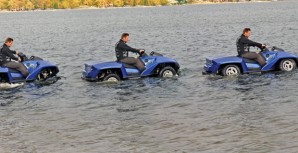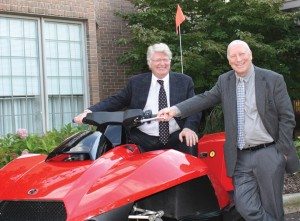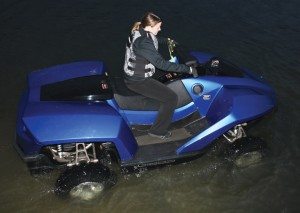
Liz Hochstedler, Associate Editor
November 28, 2012
Filed under Features, In this issue, Top Stories
Gibbs Sports Amphibians brings PWC/ATV hybrid Quadski to powersports market
The initial feeling is strange. Seconds after driving an ATV into a lake, the vehicle floats. With the push of a button, the wheels retract, and the once looming ATV is transformed into a commanding and stable PWC.
The Quadski, Gibbs Sports Amphibians? first commercially available vehicle, was introduced to select media in mid-October. It was expected to hit powersports dealers? showrooms in mid-November.
The vehicle is an 18-year labor of love for company founder Alan Gibbs, an accomplished entrepreneur hailing from New Zealand. Full development of the amphibian technology began about 15 years ago, when chairman Neil Jenkins, an experienced engineer in the automotive and aerospace industries, came on board and merged his Krafthaus with Gibbs Technologies. More than $200 million and 2 million man hours have gone into the development of Gibbs Sports? High Speed Amphibian (HSA) technology, but the Quadski is finally available at select dealerships, and other amphibian models will join the company?s lineup over the next several years.
A solution to a nagging problem
Gibbs began developing his amphibian technology to solve a personal problem. The company founder owns a farm on Kaipara Harbour in New Zealand, which has up to a mile-long tide. With so much beach between the farm and the ocean, Gibbs had no way to get a boat out to sea.
?If you take a boat out in a tractor and trailer, drop it off, take the trailer, drop in back in the shed, walk back to the boat, it?s 200 yards further out or 200 yards further in,? Gibbs told Powersports Business.
At one point, Gibbs built a catamaran with wheels, but it was too bulky for its intended uses, so he scrapped it and began his journey to develop a practical amphibian vehicle.
In an effort to launch a company to develop amphibian technology, Gibbs flew to Detroit because he thought the U.S. would have a market for amphibians. And, and as Detroit is known as the automotive capital of the country, he thought he could find the necessary engineering workforce there.
?There?s a huge talent pool of people here,? Jenkins explained. ?Almost every supplier on the face of the planet has an office or a representative here, so it made a lot of sense for us to be in this area, try to access those people and the suppliers to make life easier or to do things more efficiently.?

Gibbs Sports Amphibians chairman Neil Jenkins, left, and founder Alan Gibbs were on hand at the Pine Lake Country Club in Bloomfield Hills, Mich., for a Quadski media introduction.
Though the HSA technology has been developed in facilities in Michigan, New Zealand and England, the Quadski is being produced out of the company?s two plants in Auburn Hills, Mich. Gibbs Sports currently has 100 employees in Michigan, and the company plans to add more than 200 jobs in the next year.
In addition to the Quadski, Gibbs Sports Amphibians has about seven vehicles in prototype ? including a side-by-side and a vehicle smaller than the Quadski ? that are expected to hit the market in the next five years. The Phibian, a 30-foot, 4,500-pound, 15-seat amphibian, and the Humdinga, a 21-foot, 6,600-pound vehicle seating five to seven, were introduced to the U.S. government earlier this year. They?ll be distributed through different channels than the powersports vehicles.
The Quadski
Gibbs Sports decided the Quadski would be the first HSA vehicle commercially available because it had the fewest regulatory hurdles to overcome.
?The ATV regulations are much less complicated than the automotive regulations for cars, and as far as the EPA is concerned, it?s treated as a personal watercraft,? Gibbs explained.
The vehicle runs on BMW?s K 1300 175 hp, four-cylinder, water-cooled engine, featuring electronic fuel injection, a double-overhead camshaft and dry-sump lubrication. It has a six-speed gearbox with an automatic transmission that can be shifted at the push of a button.
?You don?t have to use a clutch, and you change gears with a button; it?s all electronic, and if you forget to change gears, it changes them for you,? Gibbs said. ?It?s very sophisticated; our guys did the development of the clutch. The gear change is like when you get in a pedal-shift car, where you push the pedals and go up and down in gears. It?s all automatic.?

The Gibbs Sports Amphibians? Quadski transitions from an ATV to a PWC and vice versa in a matter of seconds.
What makes the vehicle transition easily from ATV to PWC is the always-running jet. The differential is only in operation when land mode is activated. To transition from ATV to PWC, the rider simply enters the water through a boat lift, beach, or other accessible shoreline, drives far enough in to allow the Quadski to float and activates marine mode with a button. Upon exiting the water, the rider presses the button, putting it in land mode and accelerates up the shore.
?When you?re coming out, you have the thrust of the jet as well as the drive of the wheels, so getting out is ? you won?t have a problem getting out. You have the jet thrust and the wheels, so it will switch right up the bank, and the power of the jet combined with the wheels is enough to get you out in just about anything,? Gibbs explained.
Besides conquering the marine and land engine challenge, Gibbs Sports also had to develop a body that would encompass the motor and jet, float on water and handle the rigors of ATVing. The durable, lightweight hull is manufactured from a single-piece mold using current composite technology.
?Everything that we?ve designed on the vehicle we analyzed in terms of making the vehicle as light as we can,? Jenkins explained. ?The body is one part of it; every suspension component, everything has been through that process, so it?s more akin to designing a helicopter in terms of its engineering than it is an ATV, so it?s significant as far as engineering goes.?
Upon seeing the Quadski in person, the first thing anyone familiar with ATVs notices is its large stature. The vehicle is 10.5 feet long, 4.3 feet tall and 5.2 feet wide, with a wheelbase of 5.8 feet. With the size, Gibbs admits it?s not designed to ride on standard ATV trails, but rather, on wider trails or in open areas.
?It?s got different road capabilities from a straight ATV. It?s not a 4-wheel drive; it?s got a much wider track than a conventional ATV,? he said. ?It runs pretty good; it has a pretty wide track, really refined suspension, and it?s terrific going along tracks, rolling across pasture, and you?re going fast.?
As a PWC, the vehicle is broad and stable enough for someone to jump off it into the water. However, it?s not going to corner like a sportier PWC. But Gibbs says the wider body was designed purposefully, to give riders a more stable ride in both modes.
?In just handling a ride, narrow is bad,? he said. ?It can get you down tight trails, but it isn?t good for a vehicle because the wider it is, the more stable, so we?ve never tried to make it narrow because we want it to be a comfortable, quality vehicle.?
The Quadski has been developed to be a good quality ATV and PWC, while not topping the charts in either category.
?I have no aspirations to replace ATVs or PWCs,? Gibbs explained. ?There will be some of that, but basically it will be the customer who can get benefit from our strengths.?
The strengths of the vehicle are its HSA technology, and it?s capability to go 45 mph on land and water.
Dealer network
To distribute the Quadski, Gibbs Sports is developing a dealer network, comprised mostly of powersports dealers. The initial dealers are located in four focus areas ? the Southeast, Northeast, the Great Lakes region and Texas ? but the OEM is willing to talk to anyone who is interested in the vehicles.
?We want dealers to be quality dealers, to have the right quality assessments from other people and to have good relationships with customers, good territories. So we?re not looking to just proliferate dealerships,? Jenkins said.
Gibbs Sports reported that it already has an adequate handful of dealers for the initial launch of the Quadski, but it expects to have a network of 20-30 within the next 12 months. The company plans to produce and sell 1,000 units in the first year.
Each dealer will be required to carry two units ? one for a Gibbs display and another for sale. Only one one-rider version is available for now, and it comes in red, yellow, blue, silver and black.

Powersports Business Associate Editor Liz Hochstedler tries her hand at riding the Quadski.
Gibbs Sports quoted the price at ?about $40,000.? Though that?s significantly higher than any ATV or PWC currently costs, the company needs to recoup some of the R&D and labor costs that have gone into the technology so far. Because of the uniqueness of the model, it?s likely to appeal to those with the means to have one of the first 1,000 production models of this new vehicle.
?It?s like any new technology ? it costs a great deal to get it to this point, but over time the price will come down, and also there will be other models that are inherently cheaper. So initially it?s a high Rolls Royce-type of product, but over time, it will be in the sort of normalized price,? Gibbs explained.
After more than 15 years working on the vehicle, he?s just glad that he can finally bring it to market and begin following up with other HSA models.
?We see it primarily as a fun product,? Gibbs explained. ?You saw the amphibian series work products, but this is fun, and we call it fun squared because it doesn?t just double your fun, it squares your fun, so you go out for a day, and you don?t have to make your mind up whether you?re going to go through trails or if you?re going to go to the water, whatever. You can go out there and have heaps more fun, so this is a fun product. Some people may want to put equipment and stuff on it to make it more useful, like the rescue units and so on, but fundamentally I don?t think I can think of any motorized machine that could give me more fun.?
?
Source: http://www.powersportsbusiness.com/top-stories/2012/11/28/an-atv-a-pwc-actually-its-fun-squared/
cm punk lint buenos aires train crash argentina train crash nancy pelosi nancy pelosi gop debate
No comments:
Post a Comment